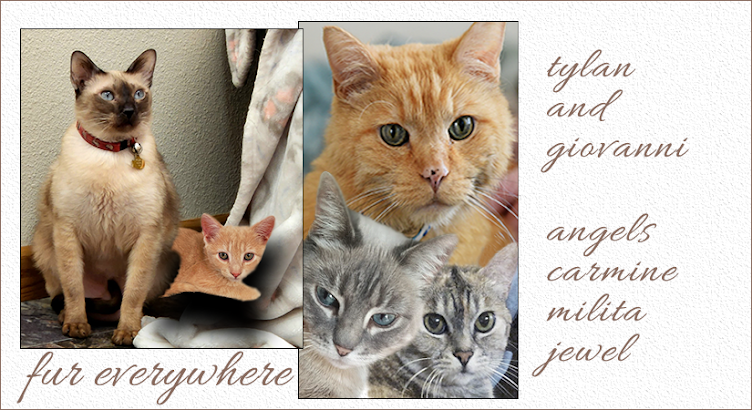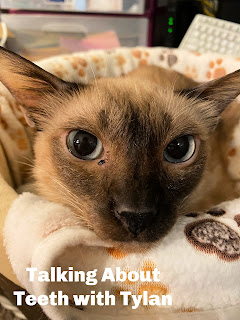Hi everyone, it's me, Tylan!
The Mom lady and I are starting a new feature on this blog called, "Talking About Teeth with Tylan." Yep, that's me!
The Mom lady and I thought I would be the perfect spokescat for feline dental health because I have had just about every dental condition under the sun. When the Mom lady adopted me, I only had two teeth left: my bottom canines. My other teeth had been removed to try to treat my stomatitis. But as many of you know, that was not successful, and I had to undergo stem cell therapy to treat my refractory stomatitis. You can check out our article on refractory stomatitis to learn more about my story.
I thought it would be a good idea to start with a discussion about the structure and function of cat teeth.
The Development of Cat Teeth
When kittens are born, they have no visible teeth. Their deciduous (temporary baby) teeth begin to break through the gums when a kitten is approximately two to three weeks of age. The deciduous teeth are typically done coming in when a kitten is approximately six to eight weeks old. A kitten has 26 deciduous teeth - 12 incisors, 10 premolars, and four canines.
Kittens typically begin teething when they are approximately 10 weeks to six months of age. Their deciduous incisors are the first to be replaced by permanent incisors. A kitten usually has all of her 30 permanent teeth by the time she reaches six to seven months of age.
The Four Types of Cat Teeth
A cat's teeth are designed to help her hunt, kill, and eat her prey. Each type of tooth in a cat's mouth serves a different purpose.
Incisors
Adult cats have 12 incisors - six on the top and six on the bottom. Incisors are the small teeth located in the front of the mouth between the two canines. Incisors are some of the first permanent teeth to erupt in a cat's mouth.
Cats use their incisors to grip their prey. These teeth are also used in grooming. Specifically, cats use their incisors to remove dirt and debris from their coat and to remove parasites, such as fleas and ticks, from their bodies. As I'm sure you know, us cats like to stay clean.
Canines
Canines look like fangs; they are sharp and pointy. Cats have four canines - one on the top and one on the bottom on each side of their mouths. Cats use their canines to deliver the fatal bite to their prey. They also use these teeth to tear their food into smaller pieces. Cats typically get their permanent canines when they are approximately five months old.
Premolars
The premolars are located behind the canines. A cat typically gets her permanent premolars between four and six months of age. A cat has 10 premolars - six on the top and four on the bottom. The premolars are used to chew food.
Molars
Kittens don't develop molars; their jaws are too small. Once their jaws get larger, cats develop permanent molars at approximately four to five months of age. Cats have four molars - one in the upper jaw and one in the lower jaw on each side of their mouths. Like premolars, molars are used to chew food. Cats in the wild use their molars to crush the bones of their prey when they are eating.
The Composition of Cat Teeth
Each tooth in a cat's mouth is comprised of a crown and one, two, or three roots. The roots are under the gumline and are not usually visible. The roots of a cat's tooth meet the crown at the cemento-enamel junction (CEJ).
Each tooth is made up of four types of tissue: enamel, dentin, pulp, and cementum.
Enamel
Enamel is the outer protective covering of the crown. Enamel is the hardest and most mineralized substance in a cat's body. Interestingly, cat tooth enamel is softer than the tooth enamel of both dogs and humans. Once enamel is lost, it cannot be restored.
Dentin
Dentin surrounds the pulp and makes up the majority of the tooth. It is the second hardest substance in a cat's body.
Pulp
Pulp is the innermost part of the tooth; it is the only tissue found in the tooth that's soft. Pulp is made up of nerves, blood vessels, and connective tissue. The nerves transmit pain, heat, and cold sensations to the brain. The blood vessels within the pulp provide the tooth with nourishment.
Cementum
Cementum covers the root's dentin. Cementum is as hard as bone. Cementum usually meets the enamel where the root and crown meet.
There you have it, the basic structure and types of teeth in a cat's mouth. I'll be back soon to talk with you all some more about teeth. Until next time, everyone!






Very informative and came at a good time as I just signed Zulu up for a tooth cleaning!
ReplyDeleteOur Sweetie has only four teeth left; her's were damaged during her years as a community cat. She still manages to bite me...slightly...because I just cannot help my grabby hands.
ReplyDeleteVery interesting! And what a cute picture of Tylan!
ReplyDeleteGreat post. I am sorry for all the troubles you had. XO
ReplyDeleteThat was terrific information Tylan and you really are most handsome!
ReplyDeleteWell I learned something about my teeth! I’ve lost a few when I had my dentals. ~Ernie
ReplyDeleteWow, thanks for this super informative article, Sierra! Nice to see you, handsome Tylan. :)
ReplyDeletePawsome information on cat teeth!
ReplyDeleteMum learned a lot ;)
Purrs, Julie
แนะนำ อัญมณี เสริมดวง ช่วยให้ได้กำไรจาก pgslot ง่ายขึ้น สล็อตออนไลน์ PGSLOT จะมาแนะนำ เครื่องประดับ อัญมณี เสริมดวงทั้งเรื่องการงาน เงินทอง หรือแม้แต่กระทั่ง การเล่นเกมสล็อตออนไลน์
ReplyDelete